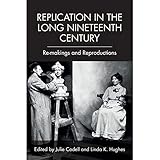Replication in the Long Nineteenth Century : Re-makings and Reproductions / Julie Codell, Linda Hughes.
Material type: TextPublisher: Edinburgh : Edinburgh University Press, [2022]Copyright date: ©2018Description: 1 online resource (320 p.) : 56 B/W illustrationsContent type:
TextPublisher: Edinburgh : Edinburgh University Press, [2022]Copyright date: ©2018Description: 1 online resource (320 p.) : 56 B/W illustrationsContent type: - 9781474424844
- 9781474424868
- Art objects -- Reproduction -- History -- 19th century
- Art -- Reproduction -- History -- 19th century
- Copying processes -- History -- 19th century
- Copying -- History -- 19th century
- Mass media and culture -- History -- 19th century
- Printing -- History -- 19th century
- Literary Studies
- ART / History / Modern (late 19th Century to 1945)
- 302.2309/034 23
- online - DeGruyter
| Item type | Current library | Call number | URL | Status | Notes | Barcode | |
|---|---|---|---|---|---|---|---|
 eBook
eBook
|
Biblioteca "Angelicum" Pont. Univ. S.Tommaso d'Aquino Nuvola online | online - DeGruyter (Browse shelf(Opens below)) | Online access | Not for loan (Accesso limitato) | Accesso per gli utenti autorizzati / Access for authorized users | (dgr)9781474424868 |
Frontmatter -- Contents -- List of Illustrations -- Acknowledgments -- 1. Introduction: Replication in the Long Nineteenth Century – Re-makings and Reproductions -- I. Replication and Networks -- 2. Replication of Things: The Case for Composite Biographical Approaches -- 3. Transatlantic Autograph Replicas and the Uplifting of American Culture -- 4. “Petty Larceny” and “Manufactured Science”: Nineteenth-Century Parasitology and the Politics of Replication -- 5. Portraying and Performing the Copy, c. 1900 -- II. Replication and Technology -- 6. Replicating Tennyson’s The Princess, 1847–1853 -- 7. Paisley / Kashmir: Mapping the Imitation-Indian Shawl -- 8. William Morris and the Form and Politics of Replication -- 9. Text and Media Replication During the U.S.–Mexican War, 1846–1848 -- III. Replication and Authenticity -- 10. Literary Replication and the Making of a Scientifi c “Fact”: Richard Owen’s Discovery of the Dinornis -- 11. Copying from Nature: Biological Replication and Fraudulent Imposture in Grant Allen’s An African Millionaire -- 12. The Failure of Replication in Nineteenth-Century Literature: Why It All Just Comes Out Wrong -- IV. Replication and Time -- 13. “Seeking Nothing and Finding It”: Moving On and Staying Put in Mugby Junction -- 14. The Origins of Replication in Science -- 15. Fathers, Sons, Beetles, and “a family of hypotheses”: Replication, Variation, and Information in Gregory Bateson’s Reading of William Bateson’s Rule -- 16. Afterword: The Implications of Nineteenth-Century Replication Culture -- Notes on Contributors -- Index
restricted access online access with authorization star
http://purl.org/coar/access_right/c_16ec
The first study of nineteenth-century replication across art, literature, science, social science and humanities This landmark study explores replication as a nineteenth-century phenomenon. Replication, defined by Victorian artists as subsequent versions of a first version, similar but changed, occurred in art, literature, the press, merchandising, and historical reproductions in architecture and museums. Replication also shaped scientific concepts in biology and geology and scientific practices in laboratories that repeated experiments as part of the scientific method. Fourteen case studies map a range of nineteenth-century replication practices and associations across art, literature, science, media and material culture. While replication stirred imaginations as well as anxieties over the industrialisation that produced a modern mass culture, Replication in the Long Nineteenth Century suggests, nonetheless, that this phenomenon is a forerunner of our contemporary digital culture.Key FeaturesThe first historical study of nineteenth-century replicationIncludes multidisciplinary case studies that rest on archival research as well as theory and analysisEstablishes a model for studying period concepts across disciplines and practicesEnhances understanding of the immense impact of digitization by illuminating its pre-history
Mode of access: Internet via World Wide Web.
In English.
Description based on online resource; title from PDF title page (publisher's Web site, viewed 29. Jun 2022)


